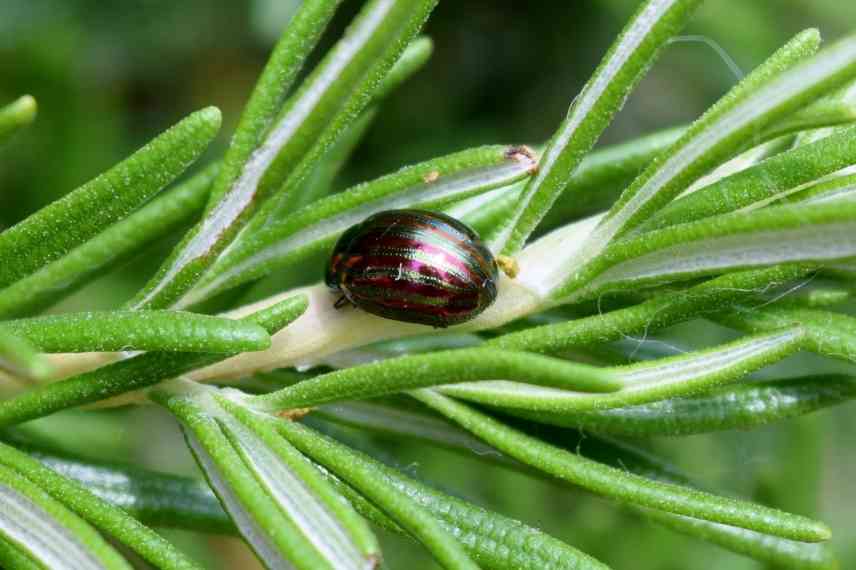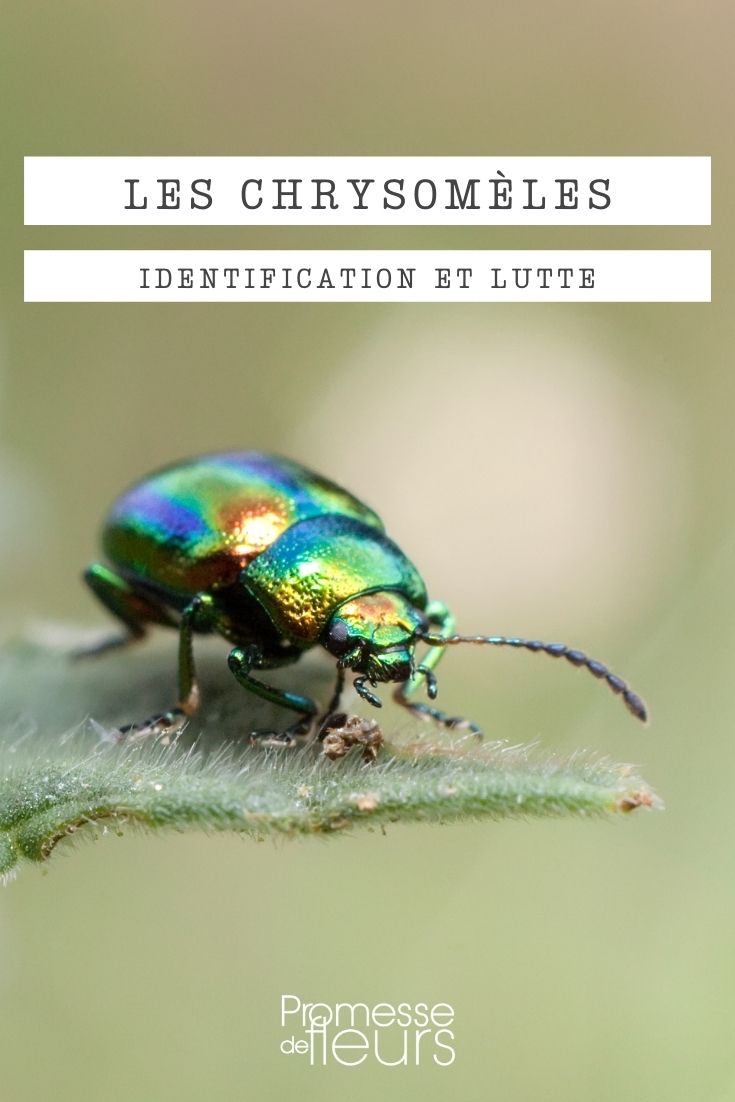
Leaf beetles
Identification, damage and treatment
Contents
True little metallic jewels in the vast kingdom of insects, the chrysomelids (family Chrysomilidae) are frequent hosts in our gardens during the warmer months. Harmless to humans, these small phytophagous beetles (feeding on plants) can nevertheless prove very troublesome when they proliferate in the vegetable patch or on certain ornamental plants. Their presence can quickly become problematic for the novice gardener, so keen are they to nibble the leaves of plants belonging to the families Lamiaceae (mint, rosemary) and Brassicaceae (cabbages, radishes, rocket).
Discover this little insect you may encounter in your little patch of green and how to control it as naturally as possible.
Life cycle of leaf beetles
Adult leaf beetles generally emerge in early spring and begin to nibble leaves. Activity pauses on the hottest summer days. From late August until early winter, depending on climate, adults mate and eggs are laid on leaves of host plants. Larvae hatch from eggs after about a month. They drop to the soil, where pupation can then begin. Larvae become adults in spring, and the cycle repeats.
Read also
A natural hedge to enhance biodiversityRosemary beetle (Chrysolina americana)
This striking species with elytra (hard, horny wings of insects) showing metallic red, green and violet sheens is very easy to identify. It measures between 5 and 8 mm.
Damage caused
These charming but voracious little creatures have a somewhat excessive fondness for sage, thyme, lavender and especially rosemary. In cases of periodic infestation, they can weaken and make plants unsightly, even completely defoliate them. However, it is very rare for this species to seriously damage your herbs, as lavender and rosemary have « learned to live with them ».
Control methods
- Manual harvesting proves to be the most effective way to control this species. Ideally, harvest them at the end of summer just before adults’ mating period to avoid possible outbreaks the following spring;
- Pyrethrum is also effective but will unfortunately also affect other harmless insects in your garden;
- If necessary, prune attacked plants after egg-laying to get rid of eggs.

Rosemary beetle
Mint leaf beetle (Chrysolina herbacea)
Also very attractive, mint leaf beetle has a metallic green‑gold colour. It measures 7 to 11 mm.
Damage caused
It mainly attacks leaves of this aromatic herb. The larval stage is, as often with chrysomelids, the most likely to cause significant defoliation damage. In colonies, damage to mint is considerable. These pests multiply very rapidly in hot, dry weather. They lay eggs directly on mint, from which larvae will emerge. This insect particularly favours open, damp places where its host plants grow (mints, European Lycopus species…). As with other species of these beetles, the adult is little troubled by predators, which refrain from devouring these insects because they taste highly unpleasant thanks to the aromatic plants they ingest.

Mint leaf beetle
Control methods
- Harvesting adults is effective (even more before autumn egg‑laying!). If this insect swarms your young plants, do not hesitate to lay a tarpaulin under plants before shaking them: guaranteed success;
- If infestation is out of control, cut stems and burn shoots containing adults and larvae;
- Decoctions of absinths have a repellent effect on this species.
Poplar leaf beetle (Chrysomela populi)
Poplar leaf beetle lives mainly on leaves of aspen (Populus tremula) and goat willow (Salix caprea) to a lesser extent. Adult visible from April to September. Larvae feed preferentially on young trees or on suckers (soft wood). When it feels endangered, it emits a foul-smelling liquid based on salicylic acid naturally present in leaves it feeds on. Easily recognised by its bright red elytra and rather large size for a chrysomelid (1 cm).
Damage caused
This insect can cause significant damage in poplar cultivation or in some osieries by reducing foliage to a “lace-like” state, thus reducing growth of infested trees.

Poplar leaf beetle
Control measures
- Collect adults as soon as they appear in April–May. Note that there can be several generations until autumn!
- Cut and burn infested and badly damaged shoots. Larvae are probably pupating on those same shoots: precursor to a new attack.
Prevention
Leaf beetles are far more often at the mercy of predators and curative sprays during larval stage.
Some species of wasps (Polistes), bugs, ladybirds and birds are very fond of them. Leaving a pile of dead wood, an unmown part of your short grass meadow or planting a country hedgerow are all shelters for beneficial insects. This is a very effective indirect means of control!
As always in pest control, prevention is better than cure: harvest adults (imagos) regularly during gardening sessions. We will put filaments in the vegetable patch from sowing to minimise damage as much as possible.
- Subscribe!
- Contents
































Comments